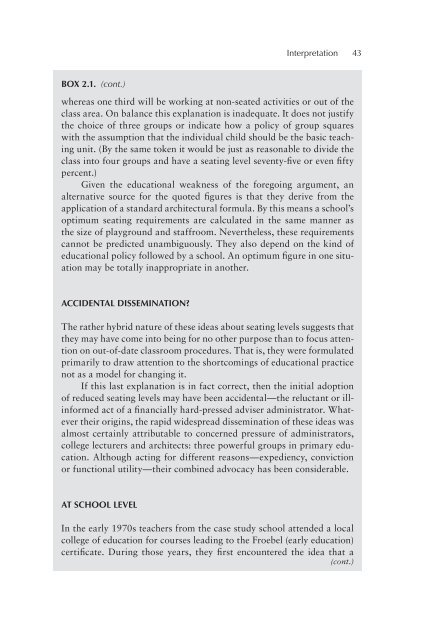How Things Work - Doha Academy of Tertiary Studies
How Things Work - Doha Academy of Tertiary Studies
How Things Work - Doha Academy of Tertiary Studies
You also want an ePaper? Increase the reach of your titles
YUMPU automatically turns print PDFs into web optimized ePapers that Google loves.
BOX 2.1. (cont.)<br />
Interpretation 43<br />
whereas one third will be working at non-seated activities or out <strong>of</strong> the<br />
class area. On balance this explanation is inadequate. It does not justify<br />
the choice <strong>of</strong> three groups or indicate how a policy <strong>of</strong> group squares<br />
with the assumption that the individual child should be the basic teaching<br />
unit. (By the same token it would be just as reasonable to divide the<br />
class into four groups and have a seating level seventy-five or even fifty<br />
percent.)<br />
Given the educational weakness <strong>of</strong> the foregoing argument, an<br />
alternative source for the quoted figures is that they derive from the<br />
application <strong>of</strong> a standard architectural formula. By this means a school’s<br />
optimum seating requirements are calculated in the same manner as<br />
the size <strong>of</strong> playground and staffroom. Nevertheless, these requirements<br />
cannot be predicted unambiguously. They also depend on the kind <strong>of</strong><br />
educational policy followed by a school. An optimum figure in one situation<br />
may be totally inappropriate in another.<br />
acciDeNtal DisseMiNatiON?<br />
The rather hybrid nature <strong>of</strong> these ideas about seating levels suggests that<br />
they may have come into being for no other purpose than to focus attention<br />
on out-<strong>of</strong>-date classroom procedures. That is, they were formulated<br />
primarily to draw attention to the shortcomings <strong>of</strong> educational practice<br />
not as a model for changing it.<br />
If this last explanation is in fact correct, then the initial adoption<br />
<strong>of</strong> reduced seating levels may have been accidental—the reluctant or illinformed<br />
act <strong>of</strong> a financially hard-pressed adviser administrator. Whatever<br />
their origins, the rapid widespread dissemination <strong>of</strong> these ideas was<br />
almost certainly attributable to concerned pressure <strong>of</strong> administrators,<br />
college lecturers and architects: three powerful groups in primary education.<br />
Although acting for different reasons—expediency, conviction<br />
or functional utility—their combined advocacy has been considerable.<br />
at schOOl level<br />
In the early 1970s teachers from the case study school attended a local<br />
college <strong>of</strong> education for courses leading to the Froebel (early education)<br />
certificate. During those years, they first encountered the idea that a<br />
(cont.)

















